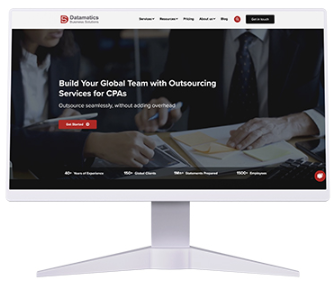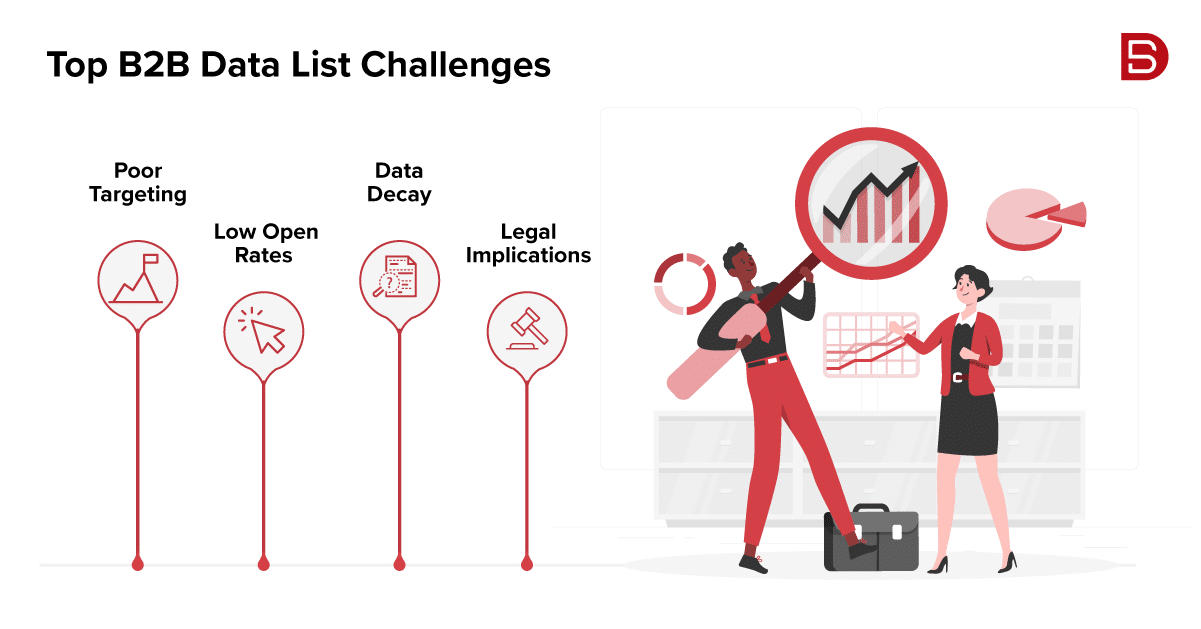Did you know that 87% of B2B marketers struggle with data accuracy according to a Demand Science report? That means relying solely on large, third-party B2B data lists might not be the shortcut to the marketing success you were hoping for. While having lots of data might seem like a surefire way to win, the reality is more complicated.
Many businesses struggle to get quality leads and end up wasting resources on strategies that don’t work. Sure, a B2B data list is important, but bombarding people who aren’t interested won’t get you far. Plus, if your data isn’t accurate or complete, you could be throwing money down the drain.
To tackle these challenges, it’s crucial to be smart about how you use your data, focusing on accuracy and relevance over sheer quantity. In this blog, we walk you through the complexities of B2B data lists and share valuable tips to overcome them.
The Basic Approaches to Acquiring a B2B Data List
Let’s look at how businesses typically get B2B data lists:
- Purchasing from data providers: Companies can buy B2B data lists from specialized providers who compile and sell databases containing business contacts and information.
- Partnering with industry associations: Some companies collaborate with industry associations or trade groups to access curated B2B data lists relevant to their niche or sector.
- Attending trade shows and conferences: Businesses often collect B2B data by networking and exchanging contact information with attendees at industry-specific events.
- Social media listening: Companies leverage social media platforms to gather B2B data by monitoring conversations, interactions, and mentions related to their industry or target audience.
- Opt-in subscriptions: Businesses may obtain B2B data through opt-in subscriptions, where companies willingly share their information in exchange for specific content or offerings.
As you can see, these methods vary significantly, especially in terms of data quality. Now, let’s explore the challenges with B2B data lists and how to solve them.
Tackling B2B Data List Challenges: Proactive Strategies for Success
Let’s jump right in and explore the four main challenges that come with an ineffective data list, along with expert tips to overcome them:
1. Challenge: Poor Targeting
Effective targeting is key for B2B email marketing because it’s not just about reaching a broad audience; it’s about connecting with the right companies or decision-makers interested in what you offer. However, when you’re working with third-party B2B leads, there are some hurdles to overcome in reaching your engagement goals, such as open rates and conversions.
Issue 1: Mismatched audience profiles
One of the biggest headaches with B2B lists is the gap between your ideal customer profiles and the leads you get from third-party sources. This mismatch can lead to communications that fall flat, wasting your resources and impacting your ROI.
Tip: To make the most of your data, segment your B2B leads in your CRM based on industry, company size, or location. This way, you can tailor your content to specific audience segments, making it more relevant and engaging.
Issue 2: Inaccurate demographic information
Third-party leads often lack accurate demographic details, making it tough to personalize your messaging based on industry, company size, or other important factors. This results in generic campaigns that miss the mark.
Tip: Over time, gather more information about your leads to refine your targeting strategies. This gradual approach ensures that your messaging evolves as you learn more about each lead, leading to more personalized interactions.
Issue 3: Limited behavioral insights
Crafting personalized and targeted content requires understanding how leads interact with your brand. But without insights into their behavior and engagement history, it’s challenging to tailor your messaging effectively.
Tip: Use predictive analytics tools like HubSpot to uncover patterns and behaviors of high-value leads. By analyzing data, you can better prioritize and target prospects with the highest likelihood of conversion.
2. Challenge: Low Open Rates
Open rates are crucial in email marketing, showing the percentage of recipients who open your emails. They give you insight into how engaging and relevant your emails are to your audience. High open rates indicate that your content, subject lines, and audience targeting are hitting the mark. Conversely, low open rates suggest there might be a disconnect between your message and what your recipients expect.
Issue 1: Leads are too cold
Third-party leads often haven’t interacted with your brand before, leaving recipients wondering why they’re receiving your emails and whether they can trust them. This lack of prior connection makes it tough to grab attention and convince decision-makers to open emails from unfamiliar sources.
Tip: To warm things up, try to establish some familiarity right off the bat. Use accounts or references to mutual connections to build trust and boost open rates.
Issue 2: Leads have mismatched expectations
Third-party B2B leads can sometimes lead to a mismatch between your email content and what your target businesses are interested in. When your content doesn’t align with their expectations, it’s no surprise that open rates suffer.
Tip: Segment your third-party B2B leads carefully to ensure your email content speaks directly to their specific needs and interests. The more tailored your emails are to each recipient’s persona and role, the better.
Issue 3: Unoptimized sending times
The timing of your email deliveries can have a big impact on open rates. Sending emails at suboptimal times, like after business hours or ignoring time zones, can result in lower open rates.
Tip: Run A/B tests to figure out the best times for engagement. By sending emails at the right times, you increase the chances of them being opened promptly upon arrival.
3. Challenge: Data Decay
Data decay happens when the information in your data list becomes outdated or inaccurate over time. This occurs as people change jobs, companies, or contact details, making it tricky for businesses to reach the right audience.
Issue: Large databases are tough to maintain
When you’re dealing with third-party B2B leads, data decay becomes an even bigger headache. The contacts you receive might be outdated or inactive, and it’s tough to stay on top of changes in companies or industries in real time. This makes it hard to keep your contact list accurate and up to date.
Tip: Keep your data list squeaky clean by regularly updating business contact details and eliminating old or incorrect information. Running frequent checks on your CRM data and using email verification tools are smart ways to prevent data decay.
4. Challenge: Legal Implications
Ensuring you’re on the right side of the law is crucial in B2B lead generation. Regulations like GDPR and CAN-SPAM are there to protect individual and business privacy. However, when it comes to third-party B2B leads, there are some legal hurdles to clear:
Issue 1: No negotiated consent
Getting explicit consent from individuals gets trickier with third-party B2B leads. It’s crucial to ensure these leads have opted in to receive communications to stay compliant, as any oversight could lead to legal trouble.
Tip: Before reaching out to third-party B2B leads, thoroughly check their data collection practices and ensure they have proper consent and follow relevant data protection regulations.
Issue 2: Data handling practices
How third-party B2B leads handle data can pose legal risks. If they don’t follow proper data protection and privacy practices, businesses partnering with them could unintentionally break the rules, leading to penalties, damaged reputation, and even lawsuits.
Tip: Clearly communicate with third-party providers about data handling practices to reduce the risk of legal trouble and ensure everyone is committed to compliance.
Issue 3: Jurisdictional variances
Different regions have different regulations for B2B communications. Engaging with third-party leads without understanding these differences can lead to accidental breaches and legal headaches.
Tip: Regularly conduct compliance audits to make sure all your B2B lead generation activities follow the rules in each region. Keeping up with regulations helps avoid unintentional slip-ups.
Conclusion
While third-party B2B data lists can be a tempting shortcut, it’s important to be aware of the challenges and take steps to mitigate them. By focusing on data quality, relevance, and following legal guidelines, you can ensure your B2B email marketing efforts are effective and compliant. Remember, it’s always better to have a smaller list of highly targeted and engaged leads than a large list of irrelevant or outdated contacts.
With the right strategies in place, you can leverage B2B data lists to reach the right audience and achieve your marketing goals. Need a reliable B2B data provider to get you started? Write to us at marketing@datamaticsbpm.com and our data experts will help you find the perfect solution for your needs.
 Select an element to maximize. Press ESC to cancel.
Select an element to maximize. Press ESC to cancel. Select an element to maximize. Press ESC to cancel.
Select an element to maximize. Press ESC to cancel. Select an element to maximize. Press ESC to cancel.
Select an element to maximize. Press ESC to cancel.
James Libera


